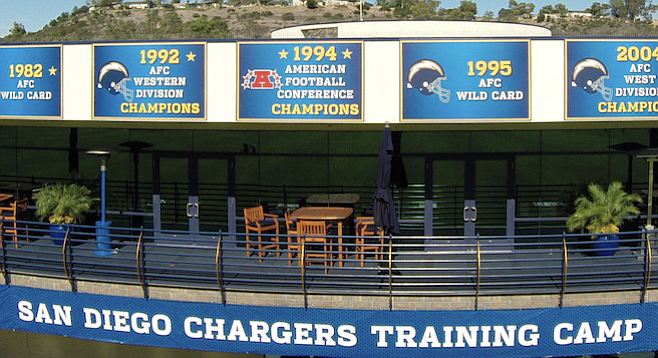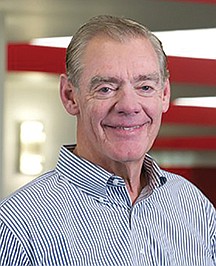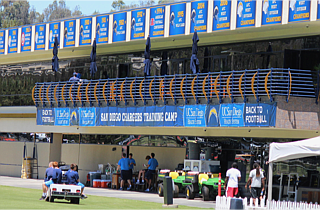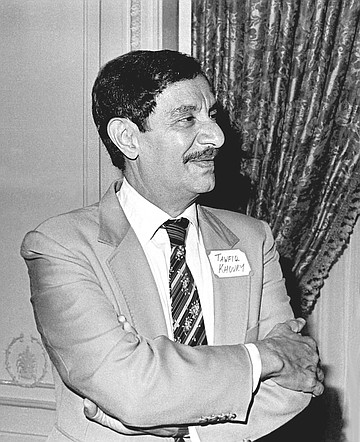 Facebook
Facebook
 X
X
 Instagram
Instagram
 TikTok
TikTok
 Youtube
Youtube

The year was 1995, and the distinctive voice of a noted elected official was on the line, insisting on going deep, deep background.
"You can’t let anybody know I’m talking, I’d be crucified. But I wanted to tell you you left a hell of a lot out of that damn Alex Spanos-picks-your-pockets story a few weeks ago,” he said.

“The big boys around here want this stadium deal real bad,” the voice continued, “and they’re going to do everything they have to do to get it Anybody who gets in the way better watch their goddamn backs.”
There were a lot of problems with the Chargers deal, said the official, but one of the worst transgressions by city officials, including city manager Jack McGrory, according to the official, was handing over $6.3 million of worth of public land, supposedly set aside for police stations, to provide the team with posh new city-owned-and-maintained executive offices and training facilities in Murphy Canyon.
“The building shall include the following elements: weight room, sports medicine facility, locker rooms, showers, other amenities, team meeting rooms, video suites, offices, and storage and shall be of size and quality comparable to such facilities at Joe Robbie Stadium,” said the city's contract with the Chargers, which also called for taxpayer provision and maintenance of "Two (2) full natural grass fields and one (1) artificial turf field.” Cost to the public? “$10 million, excluding land costs.”

“McGrory thinks he can get away from it because nobody is looking, and the Union-Tribune isn’t going to tell anybody about it. They break the law over there [city hall] all the time, and let’s face it, if you control the city attorney, the prosecutor, the city auditor, and the police chief himself, who the hell is going to catch you?”
Bond debt, to be paid off by San Diego taxpayers, would cover the center's construction and generous fixtures, but how was the city to pay for the land?
"The City and Chargers have looked at a number of sites, and have identified a site owned by San Diego Gas & Electric Company for the practice facilities," explained McGrory's October 10, 1995, report to the city council.

"The site is about 50 acres and is located at the southwest corner of Balboa and Interstate 15."
To obtain the parcel from the utility, the city council agreed to sell to a third party two so-called lots of so-called pueblo land owned by the city in the Eastgate Technology Park north of University Towne Centre.
“SDG&E will receive the benefit of the sale of Eastgate property for its property in an amount equal to $6.3 million," said the minutes.
"SDG&E has agreed to let the City take immediate possession of its property. The City will pay rent of $30,000 plus accrued taxes and interest at the close of escrow. If the exchange doesn't take place at the end of the 4 months, the City can extend the escrow for an additional 8 months to effectuate the exchange."
But there was a hitch.
The Eastgate lots represented part of the city's so-called pueblo land, remnants of once vast real estate holdings belonging to the city since the late 19th Century.
Selling the property without a public vote was forbidden.
In 1979, voters had approved a measure backed by then-mayor Pete Wilson to sell off the Eastgate property, but the ballot measure restricted use of the cash derived from the sales exclusively for police use.
Could a way be found to divert the anti-crime cash to the Chargers?
"I’ve already opined to council that I believe there is no reason why they couldn’t move in this direction [of using pueblo land money for the Chargers]," deputy city attorney Curtis Fitzpatrick related in a December 1995 interview.
"Although the [1979 ballot measure] talked about the monies going towards police, over the years since the ordinance was ratified by the voters, the general fund had had to spend a considerable amount of money [on police improvements],” he noted.
“If [the city council] had not advanced money from the general fund, the [police building] programs would have literally stalled because there simply wasn’t enough proceeds from these lands [at the time].”
Added Fitzpatrick, "The 1979 [ballot] language dictated the original use of the money for police, yes, I would concede that, but the fact remains that the general fund has advanced a considerable amount of money, and I was satisfied that the intentment [sic] of the ordinance was completed, because [voters] got what they voted for, they got the police decentralization program.”
To assure they got the state-of-the-art design they wanted, the Chargers paid for a 1992 trip by San Diego stadium officials to see the finest.

"The Chargers recently flew two members of the Stadium Authority board, Tawfiq Khoury and Donald McGrath, to Phoenix to watch the team play and to tour the Cardinals' football training facility, which is about 10 miles from Sun Devil Stadium," the Union-Tribune reported.
"In a written report to the board, McGrath — who's a big fan — said the Cardinals' 3-story state-of-the-art training facility is 'the sort of thing the Chargers should have.'"
Once the deal was done with SDG&E, the Chargers' Murphy Canyon complex was built in 1997 by Poway contractor Doug Barnhart, a longtime campaign-giver to then-mayor Susan Golding and an array of other city-hall politicos.
"We had seven months to build this thing, starting in the dead of winter," Barnhart told the U-T in February 1997. "It is because of the compressed schedule that he 'forward purchased' finish items like carpet and toilet paper holders."
Currently known as Chargers Park, the facility, like Qualcomm Stadium itself, has been a cash sink for an increasingly stretched city budget. "Qualcomm Stadium staff also maintains and performs scheduled maintenance for the Practice Facility for the San Diego Chargers," noted the city's 2014 real estate portfolio plan."
In July 2013, taxpayers foot a $84,477 bill for re-carpeting the city-owned complex, and flooding caused costly havoc in 2009, per minutes that March of the city's stadium advisory board. "Part of our agreement in maintaining the training facility is that we pay for repairs...preliminary estimates of damage to the Training Facility were at $320,000 but were expected to increase.”
2016's city budget called for an "addition of $75,000 in expenditures for supplies needed to support maintenance at the Chargers Training Facility."
It isn't immediately clear what happens to the complex when the city gets it back from the departing Chargers later this year, though police advocates, contesting Fitzpatrick’s 1996 opinion, may try to claim the funds generated by the real estate’s sale or lease.


The year was 1995, and the distinctive voice of a noted elected official was on the line, insisting on going deep, deep background.
"You can’t let anybody know I’m talking, I’d be crucified. But I wanted to tell you you left a hell of a lot out of that damn Alex Spanos-picks-your-pockets story a few weeks ago,” he said.

“The big boys around here want this stadium deal real bad,” the voice continued, “and they’re going to do everything they have to do to get it Anybody who gets in the way better watch their goddamn backs.”
There were a lot of problems with the Chargers deal, said the official, but one of the worst transgressions by city officials, including city manager Jack McGrory, according to the official, was handing over $6.3 million of worth of public land, supposedly set aside for police stations, to provide the team with posh new city-owned-and-maintained executive offices and training facilities in Murphy Canyon.
“The building shall include the following elements: weight room, sports medicine facility, locker rooms, showers, other amenities, team meeting rooms, video suites, offices, and storage and shall be of size and quality comparable to such facilities at Joe Robbie Stadium,” said the city's contract with the Chargers, which also called for taxpayer provision and maintenance of "Two (2) full natural grass fields and one (1) artificial turf field.” Cost to the public? “$10 million, excluding land costs.”

“McGrory thinks he can get away from it because nobody is looking, and the Union-Tribune isn’t going to tell anybody about it. They break the law over there [city hall] all the time, and let’s face it, if you control the city attorney, the prosecutor, the city auditor, and the police chief himself, who the hell is going to catch you?”
Bond debt, to be paid off by San Diego taxpayers, would cover the center's construction and generous fixtures, but how was the city to pay for the land?
"The City and Chargers have looked at a number of sites, and have identified a site owned by San Diego Gas & Electric Company for the practice facilities," explained McGrory's October 10, 1995, report to the city council.

"The site is about 50 acres and is located at the southwest corner of Balboa and Interstate 15."
To obtain the parcel from the utility, the city council agreed to sell to a third party two so-called lots of so-called pueblo land owned by the city in the Eastgate Technology Park north of University Towne Centre.
“SDG&E will receive the benefit of the sale of Eastgate property for its property in an amount equal to $6.3 million," said the minutes.
"SDG&E has agreed to let the City take immediate possession of its property. The City will pay rent of $30,000 plus accrued taxes and interest at the close of escrow. If the exchange doesn't take place at the end of the 4 months, the City can extend the escrow for an additional 8 months to effectuate the exchange."
But there was a hitch.
The Eastgate lots represented part of the city's so-called pueblo land, remnants of once vast real estate holdings belonging to the city since the late 19th Century.
Selling the property without a public vote was forbidden.
In 1979, voters had approved a measure backed by then-mayor Pete Wilson to sell off the Eastgate property, but the ballot measure restricted use of the cash derived from the sales exclusively for police use.
Could a way be found to divert the anti-crime cash to the Chargers?
"I’ve already opined to council that I believe there is no reason why they couldn’t move in this direction [of using pueblo land money for the Chargers]," deputy city attorney Curtis Fitzpatrick related in a December 1995 interview.
"Although the [1979 ballot measure] talked about the monies going towards police, over the years since the ordinance was ratified by the voters, the general fund had had to spend a considerable amount of money [on police improvements],” he noted.
“If [the city council] had not advanced money from the general fund, the [police building] programs would have literally stalled because there simply wasn’t enough proceeds from these lands [at the time].”
Added Fitzpatrick, "The 1979 [ballot] language dictated the original use of the money for police, yes, I would concede that, but the fact remains that the general fund has advanced a considerable amount of money, and I was satisfied that the intentment [sic] of the ordinance was completed, because [voters] got what they voted for, they got the police decentralization program.”
To assure they got the state-of-the-art design they wanted, the Chargers paid for a 1992 trip by San Diego stadium officials to see the finest.

"The Chargers recently flew two members of the Stadium Authority board, Tawfiq Khoury and Donald McGrath, to Phoenix to watch the team play and to tour the Cardinals' football training facility, which is about 10 miles from Sun Devil Stadium," the Union-Tribune reported.
"In a written report to the board, McGrath — who's a big fan — said the Cardinals' 3-story state-of-the-art training facility is 'the sort of thing the Chargers should have.'"
Once the deal was done with SDG&E, the Chargers' Murphy Canyon complex was built in 1997 by Poway contractor Doug Barnhart, a longtime campaign-giver to then-mayor Susan Golding and an array of other city-hall politicos.
"We had seven months to build this thing, starting in the dead of winter," Barnhart told the U-T in February 1997. "It is because of the compressed schedule that he 'forward purchased' finish items like carpet and toilet paper holders."
Currently known as Chargers Park, the facility, like Qualcomm Stadium itself, has been a cash sink for an increasingly stretched city budget. "Qualcomm Stadium staff also maintains and performs scheduled maintenance for the Practice Facility for the San Diego Chargers," noted the city's 2014 real estate portfolio plan."
In July 2013, taxpayers foot a $84,477 bill for re-carpeting the city-owned complex, and flooding caused costly havoc in 2009, per minutes that March of the city's stadium advisory board. "Part of our agreement in maintaining the training facility is that we pay for repairs...preliminary estimates of damage to the Training Facility were at $320,000 but were expected to increase.”
2016's city budget called for an "addition of $75,000 in expenditures for supplies needed to support maintenance at the Chargers Training Facility."
It isn't immediately clear what happens to the complex when the city gets it back from the departing Chargers later this year, though police advocates, contesting Fitzpatrick’s 1996 opinion, may try to claim the funds generated by the real estate’s sale or lease.
Comments